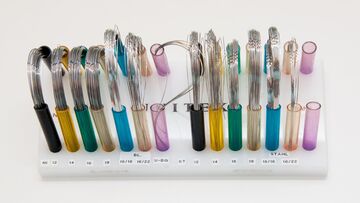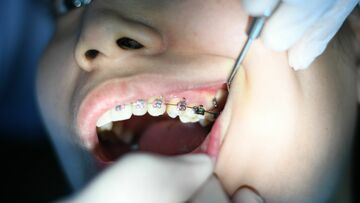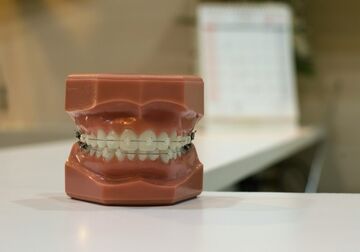
Curious about the teeth straightening options available to you? You’re not alone. Every year, around 200,000 people in Britain start orthodontic treatment. And according to one survey, around one third of all UK adults are considering treatment.

Misconceptions around orthodontic treatment will often hold people back from taking the first steps. In this guide, we’re going to break down some of the most common myths about adult braces so you can learn everything you need to know about this treatment option.
It isn’t just for teenagers
Perhaps the biggest misconception about orthodontics in the UK is that only teenagers are eligible. While it’s true that you need to be under the age of 18 to be eligible for free NHS orthodontics, anyone can access private orthodontics at any age.
So, if you narrowly missed out on free NHS orthodontics as a teenager, and your teeth have become more misaligned, it’s never too late to think about straightening your teeth.
You can repeat treatment
Another common misconception is that you can’t have braces if you already had braces as a teenager. After completing an orthodontic treatment, you will need to wear a retainer at night time to keep your teeth in the correct alignment. As soon as you stop wearing this, you can expect your teeth to shift out of alignment again.
If this happens as you get older, there is no reason you cannot start orthodontic treatment again. Your teeth won’t be more difficult to manœuvre because of previous treatment. You might even be surprised to learn about the wide range of orthodontic treatments available to you.

There are many options available
If your knowledge of braces doesn’t extend any further than tram track metal braces, you’re in for quite the surprise. There are many difficult orthodontic systems available today, including fixed and removable options.
Fixed metal braces are the most well known, and these use brackets fitted to the teeth with a wire running between them to put gentle pressure on the teeth to move them into the correct position. You need to visit the dentist regularly for adjustments.
Lingual braces are similar to fixed metal braces, but they are attached to the backs of the teeth rather than the front. This is far more discreet and allows you to straighten your teeth without it being obvious to those around you.
Invisalign is a popular orthodontic system that uses clear plastic aligners to apply gentle pressure to the teeth. Every aligner in your treatment case will move your teeth a little bit closer to perfect alignment.
Quick Straight Teeth is another orthodontic brand that offers fixed and removable aligners based on your needs. This brand focuses on straightening the front 6 teeth that are most visible when you smile, so the treatment time will be much quicker.
If you’ve been under the impression you have to deal with fixed braces for the duration of your treatment, you might be surprised to learn about the different options available today.

It’s about more than just aesthetics
Straightening your teeth is about so much more than just looking better and feeling more confident. Straight teeth are much easier to care for, as the tooth surface will not be concealed by overlapping or overcrowded teeth.
Straightening your teeth can also help to address issues with your bite alignment that could make it more difficult for you to chew your food. This can lead to digestive problems if left untreated. Problems with your bite can also lead to jaw problems and headaches.
There is no upper age limit
As long as your teeth are healthy enough to be moved, you could be an eligible candidate for teeth straightening. There isn’t an upper age limit for teeth straightening and you can choose to achieve your perfect straight smile at any age.
There are some factors that could influence your orthodontic journey. This includes the presence of dental implants and other restorations such as bridges and veneers. This won’t necessarily rule you out as a potential candidate, but it could limit the choices available to you.

You don’t have to straighten all of your teeth
Orthodontic treatment for teenagers will typically take around 2 years to complete. This is because the treatment will focus on the optimal alignment for all of the teeth in the top and bottom arches.
For adults looking for aesthetic improvements, you don’t have to spend this long straightening all of your teeth. You could speed up your treatment time by only focusing on the “social six”, which is the top front teeth visible when you smile. Limiting your orthodontic treatment in this way could mean that it is completed in as little as six months.
There are discreet options available
You don’t have to let the whole world know that you are straightening your teeth. For those working in public-facing roles, the prospect of wearing fixed metal braces might be out of the question. Thankfully, you can choose discreet teeth straightening options like Invisalign or lingual braces.
Lingual braces fit on the back of the teeth, to make it less obvious that you are having treatment. Invisalign braces are made from clear plastic and are also removable, which means you can take them out for important engagements.
Closing thoughts
If you’re thinking about straightening your teeth but have been put off by these common misconceptions, we hope that this article might have helped to clear a few things up for you. If you have any further questions about adult braces, we recommend booking a consultation with our team. We can help you to understand the options available to you and how orthodontics could change your life.
Using the latest iTero scanning technology, we can also create a 3D rendering of your smile and how it could look after teeth straightening. This can help you to decide if the time and investment is worthwhile or if you would like to explore alternative treatments, such as veneers or composite bonding.
Contact us to make an appointment
Exclusive Offer
Airflow stain removal from our hygienist
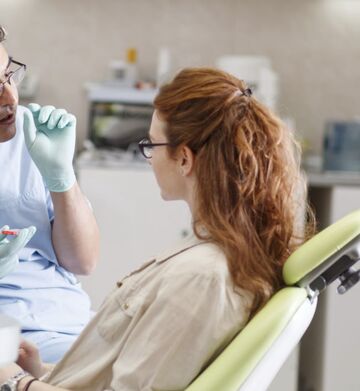
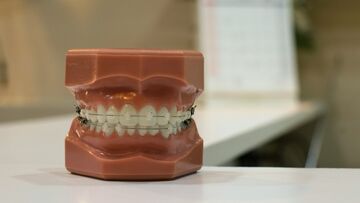
Benefits of Orthodontic Treatments
10.04.2024
Time for you perfect smile?
Book your consultation today
When visiting our practice you know you are visiting the dental professionals trained to the highest standards. You are greeted by our welcoming staff, who share the same aim, to make your visit with us as comfortable and stress free as possible.

